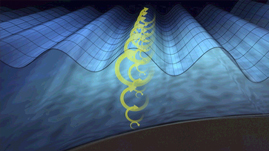Teachers' Domain - Digital Media for the Classroom and Professional Development
User: Preview


Source: QUEST:"Big Wave Science"



If you have dreams of surfing the perfect wave, there is so much more to learn than just hanging-ten. Waves can come from many different types of sources, yet they all have very similar physical properties. Before you learn to surf the big waves, you should learn the science behind how they are created. In this video from QUEST, learn about the origins and the power of Big Waves along the Northern California Coast.
Energy is able to travel through objects in the form of waves. Newton’s law of conservation of energy states that energy within a system remains constant, but that the energy in the system is able to change forms. The source of wave energy can result from many different types of interactions. When you visit the ocean and see the waves, what you are actually witnessing is energy moving through the water.
When wind blows against the surface of the ocean, the friction between air molecules and water molecules facilitates the process through which kinetic energy is transferred to the ocean. The result of this transfer of energy eventually becomes a wave. The stronger the wind, the larger the wave will become. When there is enough energy in the wind, waves can travel thousands of miles before they reach coastline. During their journey toward land, ocean waves can continue to gain strength before they arrive on land. When this happens the energy that has built up in the wave over the course of its journey will be forced upwards by the rising ocean floor, resulting in a breaking wave. Waves generated by the wind are known as wind waves.
The size of a wind wave depends on three factors: The speed or strength of the wind. The distance the wind has to travel to over the ocean's surface, known as the fetch, and lastly the time the wind has to blow over the water. Ocean waves are measured by the wave height, the distance from the lowest point on the wave, the trough, and the crest, the highest point on the wave; the period, the time between one passing wave to the next and the wave length, the distance between one wave crest and the next. Some energy sources for waves include geological activity, such as earthquakes, sub-oceanic volcanoes erupting, or even meteorites that impact the oceans. Think of throwing a stone into a puddle, or small lake, or jumping into a pool. The ripples, or waves that result from the impact express a measure of the energy from the stone, or the force of your body hitting the pool.
 Loading Standards
Loading Standards